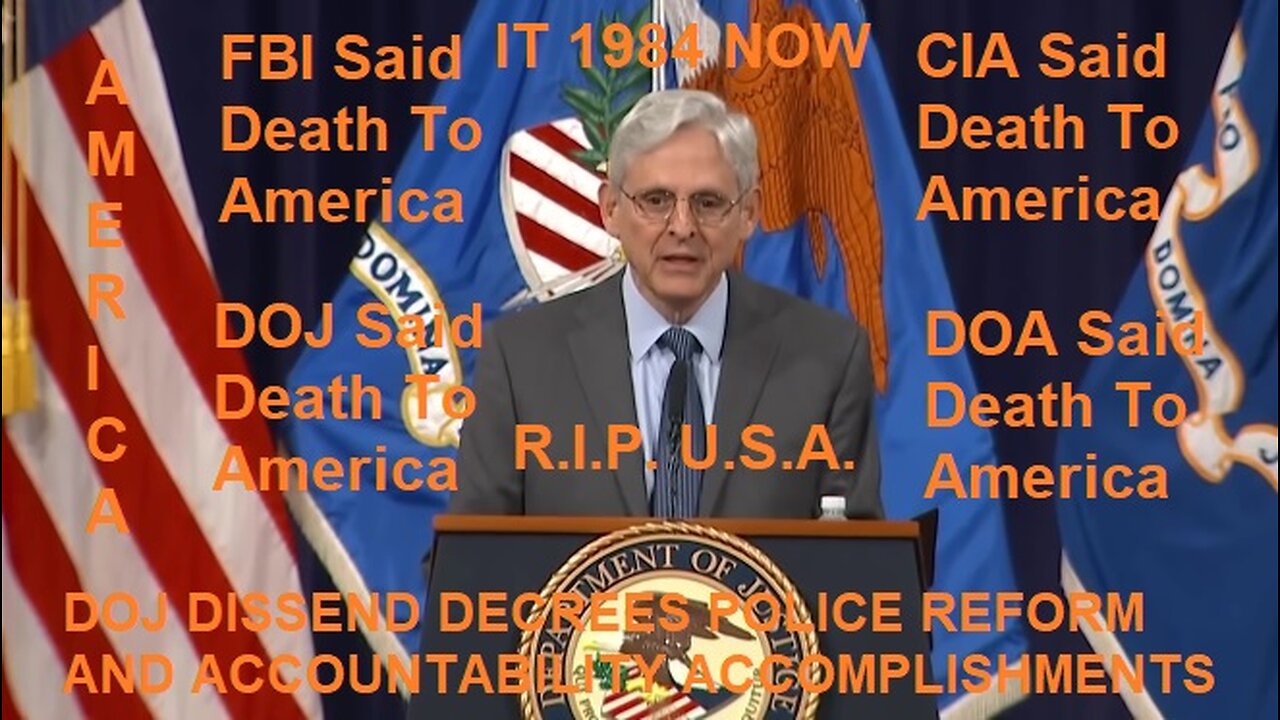Premium Only Content

DOJ DISSEND DECREES POLICE REFORM AND ACCOUNTABILITY ACCOMPLISHMENTS
Since the start of the administration, the Department of Justice’s Civil Rights Division has opened 23 investigations into police departments. In the first five fiscal years of the administration, the department has opened more than twice as many investigations than were opened in the previous five fiscal years. The department is enforcing 17 agreements with law enforcement agencies, including 13 consent decrees, and one post-judgment order.
Consent Decrees: New Orleans Police Department, Puerto Rico Police Department; Seattle Police - Department; Portland (Oregon) Police Department; Detroit Police Department; Virgin Islands Police - Department; East Haven (Connecticut) Police Department; Warren (Ohio) Police Department; Albuquerque (New Mexico) Police Department; Los Angeles County Sheriff’s Department-Antelope Valley; Cleveland Division of Police; Meridian (Mississippi) Police Department; Maricopa County (Arizona) Sheriff’s Office
Out-of-Court Agreements: Suffolk County (New York) Police Department, Beacon (New York) Police - Department, Missoula County Attorney’s Office
Post-Judgment Order: Melendres v. Arpaio (United States as Intervenor) Over the past three years, the department has successfully concluded the implementation of two consent decrees, as well three memorandums of agreement (MOA).
Consent Decrees: Los Angeles Police Department and District of Columbia Metropolitan Police Department
MOA: Orange County (Florida) Sheriff’s Office, University of Montana Department of Public Safety and Missoula (Montana) Police Department
The vast majority of law enforcement agencies enter into voluntary agreements, however, the department has filed suit when agencies have been unwilling to correct patterns or practices of misconduct. The department is currently in litigation with regard to two law enforcement agencies:
Alamance County (North Carolina) Sheriff’s Office; Colorado City (Arizona) Police Department
The department currently has eight open investigations. In the majority of these investigations the department has issued findings or technical assistance letters.
Findings: Ferguson (Missouri) Police Department; Miami Police Department; Newark (New Jersey) Police Department
Technical Assistance Letters: Yonkers (New York) Police Department
Ongoing Investigations: Chicago (Illinois) Police Department; Baltimore (Maryland) Police Department; Ville Platte (Louisiana) Police Department; Evangeline Parish (Louisiana) Sheriff’s Office
The department does not always find constitutional violations. In the past six years, the department has concluded six investigations of law enforcement agencies without finding constitutional violations.
Austin (Texas) Police Department, Escambia County (Florida) Sheriff’s Office, Lorain (Ohio) Police Department, Harvey (Illinois) Police Department, Schenectady (New York) Police Department, Inglewood (California) Police Department.
https://www.justice.gov/opa/file/797666/download
Our public discourse has been in decline for so long that it was bound to come to this, right?
Rep. Maxine Waters called on her supporters to publicly confront and harass members of the administration in response to the “zero tolerance” policy that led to the separation of families at the border.
“Let’s make sure we show up wherever we have to show up. And if you see anybody from that Cabinet in a restaurant, in a department store, at a gasoline station, you get out and you create a crowd. And you push back on them. And you tell them they’re not welcome anymore, anywhere. We’ve got to get the children connected to their parents,” Waters said at the Wilshire Federal Building, according to video of the event.
https://www.justice.gov/crt/page/file/922456/download
Following the discovery and disclosure of the Rampart Area Corruption Incident by the Los Angeles Police Department, the United States Department of Justice (DOJ) notified the City of Los Angeles that it intended to file a civil suit alleging that the Department was engaging in a pattern or practice of excessive force, false arrests and unreasonable searches and seizures.
The Director of the Office of Constitutional Policing and Policy is Who ?
Whenever the DOJ has reasonable cause to believe such violations have occurred, they may obtain a court order to eliminate the pattern or practice. On that basis, the DOJ has entered into consent decrees with other law enforcement agencies throughout the United States including the Pittsburgh, Pennsylvania Police Department; Steubenville, Ohio Police Department; and the New Jersey State Police.
A consent decree is an agreement between involved parties submitted in writing to a court. Once approved by the judge, it becomes legally binding.
In making these allegations, the DOJ recognized that the overwhelming majority of Los Angeles police officers perform their difficult jobs in a lawful manner. The City denied the allegations in the DOJ complaint and entered into negotiations with DOJ. However, to avoid potentially divisive and costly litigation and to promote the best available practices and procedures for the Department, the City entered into the Civil Rights Consent Decree.
The Consent Decree will last a minimum of five years during which the Department must demonstrate substantial compliance with the Decree’s provisions.
The Consent Decree is intended to promote police integrity within the Department and prevent conduct that deprives individuals of their rights, privileges, or immunities protected by the Constitution of the United States. The Consent Decree places emphasis on the following nine major areas:
Management and supervisory measures to promote Civil Rights Integrity;
Critical incident procedures, documentation, investigation and review;
Management of Gang Units;
Management of Confidential Informants;
Program development for response to persons with mental illness;
Training;
Integrity Audits;
Operations of the Police Commission and Inspector General; and, Community outreach and public information.
On November 2, 2000, the City Council and the Mayor approved the Consent Decree negotiated between the City and the DOJ. However, the Consent Decree was not immediately entered (i.e. approved and signed) by Federal District Court Judge Gary A Feess. Nonetheless, the Department formed the Consent Decree Task Force (CDTF) within Administrative Group to plan for, coordinate, track, monitor and report on the Department’s compliance with the Decree’s provisions.
The Court formally entered the Consent Decree into law on June 15, 2001. In the upcoming month, Department employees can expect to receive Consent Decree-related orders, notices, and training, articulating new operational policies and procedures.
Wilshire and Hollywood Area patrol officers recently began a pilot program to evaluate the use of hand-held computers for motor vehicle and pedestrian stops. Data collection is scheduled to begin Department-wide by November 1, 2001.
The men and women of the Los Angeles Police Department are deeply committed to serving all the people and all the various communities of the City.
Compliance with the Consent Decree is the baseline for, and not the ultimate standard, by which the Department’s commitment to excellence will ultimately be measured.
The communities of Los Angeles expect and deserve the finest service possible from their police officers. To that end, the Department shall consider the Consent Decree as only a part of a more comprehensive effort to provide the highest level of protection and service.
City of Baltimore Consent Decree On April 7, 2017, the City of Baltimore and the Department of Justice (DOJ) entered into a Consent Decree, which is a court enforceable agreement to resolve DOJ's findings that it believed the Baltimore City Police Department (BPD) had engaged in a pattern and practice of conduct that violates the First, Fourth, and Fourteenth Amendments to the United States Constitution, and certain provisions of federal statutory law.
Mayor Brandon M. Scott and the City of Baltimore will work together to reform the Baltimore Police Department and build the bond of trust that must exist between the community and the City's police officers. The goal of the consent decree is to have a stronger police department that fights crime while it serves and protects the civil and constitutional rights of Baltimore City residents.
The decree’s requirements focus on building community trust, creating a culture of community and problem-oriented policing, prohibiting unlawful stops and arrests, preventing discriminatory policing and excessive force, ensuring public and officer safety, enhancing officer accountability and making needed technological upgrades. Under the agreement, the parties will jointly recommend an independent monitor to the court to assess whether the requirements of the agreement are being implemented. The independent monitor will report publicly on BPD’s implementation efforts on a regular basis. As part of the process, the parties requested that the court provide an opportunity for members of the public and stakeholders throughout Baltimore to provide written submissions to the court about the proposed decree. The public hearing on the fairness of the proposed consent decree was held on April 6, 2017, wherein dozens of members of the community provided feedback and support for the consent decree. The Court then entered the Consent Decree the next day, on April 7, 2017.
Under the consent decree the City of Baltimore and the Baltimore Police Department will work with communities to implement comprehensive reforms that will ensure:
Baltimore establishes a Community Oversight Task Force to recommend reforms to the current system of civilian oversight.
BPD adopts a policing approach that is community-oriented and based on problem solving principles.
Officers’ voluntary interactions are professional and courteous, and officers conduct all investigatory stops, searches and arrests in a manner that protects people’s rights.
BPD provides equal protection of the law for all individuals, including providing impartial policing services.
Officers use appropriate de-escalation techniques and attempt to resolve incidents without force when possible; use force in a manner that is proportional to the threat presented; and BPD’s use of force policies, training and review systems provide sufficient guidance, skills and accountability.
BPD transports detainees in a manner that keeps them safe.
Officers respect the First Amendment rights of all persons.
BPD investigates sexual assault thoroughly and without gender bias.
Baltimore conducts an assessment to minimize youth involvement with the juvenile and criminal justice systems, as appropriate, and that officers approach interactions with youth in a manner appropriate to their age.
Baltimore conducts an analysis of gaps in the city’s mental health system in consultation with a committee of behavioral health experts and service providers, and BPD instructs and dispatches officers who are properly trained in interacting with people in crisis or with behavioral health disabilities when a police response is appropriate.
Allegations of employee misconduct are fully, fairly and efficiently investigated; that all investigative findings are supported by the appropriate standard of proof and documented in writing; and that all officers who commit misconduct are held accountable pursuant to a disciplinary system that is fair, consistent and provides due process.
Officers receive necessary equipment, policy guidance, training and support to do their jobs safely and effectively, and BPD performs a staffing study to ensure a sufficient number of officers and supervisors.
The Consent Decree is a mandate for positive transformation to benefit the community and the Department.
In 2016, the United States Department of Justice (DOJ) investigated the Baltimore Police Department (BPD) and found that BPD engaged in a pattern and practice of unconstitutional policing.
To address the findings, the BPD, the City, and DOJ entered into an agreement called a Consent Decree. It is a federal court order that requires changes to the Department so it can police in a constitutional manner. This includes updating and creating policies, revamping training, building systems of accountability, investing in modern technology and much more.
A federal judge oversees the implementation of these changes with the help of a group of experts from across the country called the Monitoring Team. Each year, the Monitoring Team, DOJ, BPD, and the City agree to a monitoring plan that sets deadlines for individual steps in the reform process.
https://www.justice.gov/opa/file/925056/download
https://communityresourcehub.org/wp-content/uploads/2021/06/0602_DOJ_B.pdf
https://www.mdd.uscourts.gov/sites/mdd/files/ConsentDecree.pdf
https://scholarlycommons.law.northwestern.edu/cgi/viewcontent.cgi?article=6766&context=jclc
https://www.justice.gov/opa/press-release/file/1109621/download
FACT SHEET: JUSTICE DEPARTMENT CONSENT DECREE WITH BALTIMORE POLICE
DEPARTMENT AND THE CITY OF BALTIMORE
The Justice Department, the city of Baltimore and the Baltimore City Police Department (BPD) have reached agreement on a consent decree to address systemic problems identified during the department’s
investigation of BPD. Key provisions include:
COMMUNITY OVERSIGHT TASK FORCE:
• Establishes a Community Oversight Task Force with responsibility to assess civilian oversight of BPD and report publicly on its findings and recommendations.
COMMUNITY POLICING AND ENGAGEMENT:
• Establishes mandatory annual training on community policing and problem-oriented policing for all officers.
• Requires the development of community-engagement plans to create opportunities for routine and frequent positive interactions between officers and community members.
• Requires a public annual report on BPD’s community policing efforts.
STOPS, SEARCHES, ARRESTS AND INTERACTIONS:
• Advances policies and training on the constitutional requirements for conducting stops, searches and arrests, and robust supervisory review of stops, searches and arrests to ensure that officers apply proper standards when taking these actions.
• Ensures supervision to avoid unnecessary arrests for low-level offenses like loitering and disorderly conduct.
IMPARTIAL POLICING:
• Advances policies and training prohibiting discriminatory policing in BPD’s enforcement activities.
• Requires training for all officers on the existence of implicit bias and how to mitigate it.
RESPONDING TO AND INTERACTING WITH PEOPLE WITH BEHAVIORAL HEALTH
DISABILITIES OR IN CRISIS:
• Advances policies and training for all officers to improve coordination with community behavioral health providers and a comprehensive assessment to identify gaps in the behavioral health service system and to recommend solutions.
USE OF FORCE:
• Advances policies and training to emphasize de-escalation, using tactics that defuse incidents and minimizing both the need to resort to force and the risk of harm to the officer.
• Ensures requirements for reporting and review of force to continually improve officers’ skills in incidents involving force.
INTERACTIONS WITH YOUTH:
• Advances policy and training on officers’ interactions with youth to ensure officers respond in a developmentally appropriate manner to incidents involving young people.
• Establishes an assessment involving community organizations, experts and youth advocates of the city’s efforts to decrease youth involvement with the juvenile and criminal justice systems.
TRANSPORTATION OF PERSONS IN CUSTODY:
• Advances policies and training to ensure that all people in custody are transported safely.
FIRST AMENDMENT PROTECTED ACTIVITIES:
• Advances policies and training to ensure that BPD officers respond appropriately to the exercise of rights protected by the First Amendment, including speech, lawful protest and public observation and recording of police activity.
HANDLING OF REPORTS OF SEXUAL ASSAULT:
• Advances policy, training, supervision and oversight of sexual assault investigations to promote a victim-centered, trauma-informed approach and combat gender bias.
TECHNOLOGY:
• Establishes a plan for deployment of new technology that will assist BPD officers to do their jobs effectively and constitutionally, and measures to ensure that newly implemented technologies are transparent and subject to public disclosure.
SUPERVISION:
• Ensures that BPD develops and reviews new and revised policies and procedures in a way that provides for public comment, officer input and court oversight.
• Provides for increased and effective officer training, including a revitalization of BPD’s Field
Training Officer program.
MISCONDUCT INVESTIGATIONS AND DISCIPLINE:
• Advances policies and systems to ensure that all complaints of officer misconduct are thoroughly investigated, and that BPD holds officers to the highest standards of integrity.
• Establishes regular, public reporting about practices and trends in misconduct investigation and enforcement.
COORDINATION WITH BALTIMORE CITY SCHOOL POLICE FORCE:
• Requires a comprehensive assessment of BPD’s coordination with the Baltimore School Police to identify areas for improvement.
RECRUITMENT, HIRING AND RETENTION:
• Requires a review of BPD’s hiring practices to ensure that BPD attracts and hires a diverse group of qualified applicants, including employment incentives, background checks and psychological testing.
• Requires a comprehensive staffing study to assess the appropriate number of personnel for BPD to fulfill its mission and police effectively and constitutionally, and appropriate implementation of the study.
• Establishes an employee assistance program for BPD officers that allows access to counseling, mental wellness services and peer support.
IMPLEMENTATION AND ENFORCEMENT OF CONSENT DECREE:
• Filed in federal court and operates as a federal court order once approved by a judge.
• Overseen by an independent monitor, recommended by the parties with public input and appointed by the judge, who will report on the city’s progress in implementing the agreement.
• Terminated when the city and BPD have demonstrated that they have achieved and maintained full and effective compliance.
https://www.justice.gov/opa/file/925026/download
What Consent Decrees Looked Like In Other Cities, As The DOJ Wraps Up Its Investigation Into Louisville Police.
Louisville, Kentucky — Louisville Metro Police Department
City Population: 628,594
Number of Police Officers: 1,019
Came Under Consent Decree: TBD
In the coming weeks, the Department of Justice is expected to release the findings of its investigation into whether the Louisville Metro Police Department engages in practices that violate the United States Constitution or federal law.
In such investigations, the DOJ looks for patterns or practices of constitutional violations: things like excessive use of force, racially-discriminatory policing, illegal searches and seizures and interfering with the expression of First Amendment protected free speech. If such violations are found, the DOJ will likely propose a consent decree: a negotiated agreement between the city and the federal government for the city to address those violations while being monitored.
“It gives the federal government a way to address those things in police departments that either cannot or will not address the problem and fix it themselves,” said David Harris, a University of Pittsburgh professor of law who studies police behavior and consent decrees. “So it has great utility and is one of the very few things you can do to take policing as a system, as an institution, and try to proactively fix it looking forward.”
Harris added that while an individual event — like the police killing of Breonna Taylor — can trigger a DOJ investigation, the DOJ focuses on broader patterns of misconduct instead of individual incidents. (In DOJ criminal investigations separate from its pattern or practice probe, seven LMPD officers have been charged in misconduct cases so far this year.)
The fixes demanded by consent decrees often take the shape of widespread reform, new technology and inflated police budgets.
So far, Louisville has tried to get ahead of the findings by implementing numerous reforms, which city officials have said could potentially shorten the length of a consent decree, which have the potential to drag on for many years.
Danny Murphy, a consultant hired by the city who previously oversaw consent decree reforms and compliance in Baltimore and New Orleans, told Metro Council last year that Louisville could expect to pay $8 to $10 million per year under a consent decree.
Harris, the policing expert at the University of Pittsburgh, said that consent decrees are indeed expensive undertakings and often fall on cities that are already stretched thin financially.
“But I think what people fail to understand is: If this costs a lot, so does terrible policing. It’s just that that cost is foisted onto poor people generally, communities of color who suffer under unconstitutional policing. They pay that price,” he said. “So when you ask ‘what’s the dollar cost?’ you have to ask ‘what’s the alternative?’ too.”
As Louisville prepares for the release of the DOJ’s findings and anticipates conversations about a consent decree, LEO Weekly took a look at the experiences of three other cities of (roughly) similar size that have seen their police departments come under consent decree.
Cleveland, Ohio — Cleveland Division of Police
City Population: 367,991
Number of Police Officers: 1,400
Came Under Consent Decree: 2015
After a series of police killings — including an incident that saw officers kill two unarmed Black people by firing 137 shots at the vehicle they were in after a pursuit triggered by the sound of a car backfiring — Cleveland’s mayor asked the DOJ to come in and investigate the department in 2012.
In December 2014, the DOJ said they found a pattern of excessive force in the Cleveland Division of Police that was fed by a lack of accountability, inadequate training, ineffective policies and a lack of community engagement. The DOJ also wrote that CDP officers “carelessly” fi red their weapons.
Just weeks before the DOJ report came out, a Cleveland police officer shot and killed 14-year-old Tamir Rice, a Black child who was carrying a toy gun in a city park.
With Cleveland in its eighth year of a consent decree, patience is wearing thin for some. Last month, first-year Mayor Justin Bibb, a Democrat, called for an exit.
“The quickest we can get out of this decree, the better it will be for the police department and the taxpayers, so we can kind of use that money to reinvest back in the community in the long term,” he said at a press conference according to northeast Ohio public news radio station WKSU.
There is also significant pushback from the police union, the Cleveland Police Patrolman’s Association, which called Cleveland’s safety director a DOJ “puppet” last year after 13 officers were fi red for misconduct.
As part of the consent decree, the Cleveland Community Police Commission was created to bring community input into police reform. Jason Goodrick, the executive director of that commission, has doubts about the long-term effectiveness of consent decree reforms though, saying that police departments nationwide are resistant to lasting change.
“Police are very good at outlasting the political, short-term need for them to reform. And you typically see the same cycle of reform, then police using increasing crime and a fear of crime as a reason to lessen reform,” he told LEO Weekly. “It’s like a circle of life that continues over and over in city after city.”
However, Goodrick said, in the short term, police departments can sometimes see dramatic change with federal oversight and that he believes the consent decree process has engaged the community more than before.
“You’re going to see short-term change, you’re going to see an increase in the awareness, increase in dialogue, increase in community involvement — all of those are positive. But then the downside: They’re long, they’re costly, we don’t know for sure what the outcome’s going to be,” he said.
Baltimore, Maryland — Baltimore Police Department
City Population: 567,498
Number of Police Officers: 2,400 *2021
Came Under Consent Decree: 2017
To Baltimore community organizer and Citizens Policing Project Director Ray Kelly, the city’s five years under consent decree have been a glacially slow process that has not seen relations between police and the community improve.
“The process is excruciatingly slow,” he said. “It’s understandable when we’re talking about 150 years in a lot of cases of oppressive policing and that culture.”
The department came under DOJ investigation in 2015 following the killing of Freddie Gray, a 25-year-old Black man who died from injuries he sustained while being transported by police officers. While police said Gray was arrested for having an illegal switchblade knife, the State’s Attorney for Baltimore City later said the knife he had was legal.
The DOJ declined to prosecute any officers in Gray’s death, saying there was insufficient evidence. But in 2016, the DOJ said its separate wide-ranging investigation into the Baltimore Police Department found a pattern of civil rights violations, with officers using strategies that unlawfully subjected African Americans to higher rates of stops, searches and arrests. They also said there was a pattern of excessive force and interference with the right to free expression.
Just before the consent decree was approved by a federal judge in 2017, the eight members of the Baltimore Police Department’s elite Gun Trace Task Force were arrested on federal racketeering charges, with members stealing narcotics and cash from drug dealers and shaking down motorists in incidents now immortalized in the HBO mini-series “We Own This City.”
The city’s woes have continued since the consent decree started in 2017.
Since coming under consent decree, the city has run through four police chiefs and three mayors. Of those police chiefs, one resigned after being charged with failing to file tax returns for three years. He would later spend 275 days in prison. Of those three mayors, one was sentenced to three years in prison on fraud and tax evasion charges.
Meanwhile, the city has registered at least 300 homicides for seven consecutive years.
Like Goodrick in Cleveland, Kelly said he sees a see-sawing cycle between calls for reform and police using narratives of rising violence to push back against reform.
Data echoes his feelings about the relationship between the community and police remaining bad following the consent decree; A public perception survey of Baltimore residents that was commissioned to comply with the consent decree found that 60% of respondents did not believe BPD made the city safer. In that same survey, 51% said police did not treat people with respect.
But despite the shortcomings of the consent decree, Kelly thinks it is necessary.
“I think people have to recognize this is systemic and cultural change and it takes time,” he said. “I in no way, shape or form feel that we don’t need the consent decree. Because the alternative is mistreatment of Black people all around the country as there’s always been.”
New Orleans, Louisiana — New Orleans Police Department
City Population: 376,971
Number of police officers: 1,000
Came under consent decree: 2013
After nearly a decade under consent decree, New Orleans is another city trying to escape its federal oversight.
Last month, New Orleans Mayor LaToya Cantrell called for an end to the consent decree, saying it was an “overburden” on officers on the force today, who were in no way responsible for the actions of officers who landed the city in the DOJ’s crosshairs.
“The consent decree handcuffs our officers by making their jobs harder, pestering them with punitive punishment and burying them with paperwork that is an overburden,” she said in early August, according to NBC News.
In response to a motion fi led by the city to end the consent decree, the federal judge overseeing the agreement warned that the department’s ongoing staff shortage of hundreds of officers was an “emergency” that was dragging the force into non-compliance.
Soon after taking office in 2010, then-New Orleans Mayor Mitch Landrieu asked the DOJ to investigate his city’s police department, writing that many considered it “one of the worst police departments in the country” and asserting that “nothing short of a complete transformation” was needed to keep citizens safe.
“The NOPD has long been a troubled agency,” the DOJ said in its opening words of the 2011 findings of their resulting investigation. “Basic elements of effective policing — clear policies, training, accountability and confidence of the citizenry — have been absent for years. Far too often, officers show a lack of respect for the civil rights and dignity of the people of New Orleans.”
The city came under consent decree in 2013.
Matthew Nesvet, an anthropologist and police reform expert, spent a year working in New Orleans as a consent decree monitor. That experience left him with a bad taste in his mouth, questioning the effectiveness of the consent decree and the possibility of real change to occur.
To meet metrics for community engagement, he said, precincts would share pictures of officers interacting with members of the public. On another occasion, he recalled, monitors observed and said nothing when police emailed a safety warning about a Black Lives Matter protester who was critical of the police on social media despite no indication of criminal activity. To Nesvet, it felt like officers weren’t changing the way they were policing the city, just the kind of paperwork they filled out. And the monitors, consultants and companies offering technology solutions were “a revolving door of government contractors” cashing in on a lucrative cottage industry.
“It’s not a permanent infrastructure to monitor the police,” he said. “A city is dependent on these independent monitors to sort of mandate compliance. As soon as they leave, whatever small degree of compliance they offer — which I think is less than they claim — goes away.
Consent decrees can reduce the number of police-related killings, but only when used alongside court-appointed monitoring. Consent decrees – agreements for reform between police departments and the government – are one way to reform police forces which engage in patterns of misconduct. Using national data covering over 900 police departments, Li Sian Goh assesses whether consent decrees are effective, finding that their use – alongside court-appointed monitoring – was linked to a 29 percent reduction in officer-related fatalities.
In 2018, the Trump administration announced that it was limiting the use of consent decrees, creating a series of roadblocks to render them both ‘rare and ineffective’. Consent decrees, which are legally binding agreements between the government and law enforcement agencies that have been found to have routinely engaged in a pattern or practice of misconduct, such as the use of excessive violence, have been negotiated in cities such as Ferguson, Baltimore, Chicago, and Los Angeles. They routinely address departmental policies relating to recruitment, training, discipline, and documentation – and are a key instrument in policing reform and accountability efforts.
Although important, consent decrees are only one of a number of possible outcomes of Department of Justice (DOJ) interventions in law enforcement agencies. DOJ interventions generally begin with an investigation to establish the existence of a pattern or practice of misconduct in the police department, usually following a high-profile use of force incident. These investigations usually take a year, during which DOJ officials review existing policies and practices, speaking to a wide range of parties including patrol officers, officers in management positions, citizens, and community groups.
Following the investigation, the DOJ generally releases its findings, after which three possible options exist. First, the DOJ may conclude that there is no evidence of systematic misconduct and take no further action. Second, the DOJ may issue a technical assistance letter, a policy document outlining recommended policy changes that departments are not legally obligated to implement. Technical assistance letters were the preferred option of the George W Bush administration: between 2000 and 2008, no new negotiated settlements were initiated and the DOJ instead opted to issue technical assistance letters in departments it investigated. Third, the DOJ may decide to pursue a consent decree. Consent decrees take years to complete – the Los Angeles Police Department’s decree began in 2001 and concluded in 2013 – and can cost millions of dollars to implement. The consent decree is often but not always accompanied by the court appointment of a monitoring team to oversee the reforms.
Some researchers have reported that consent decrees are generally effective in ensuring that needed reforms occur, although others have cast doubt on the lasting effect of these reforms following the closure of the decrees. To date, no studies have sought to verify the effect of consent decrees or other forms of federal intervention on the number of police. One of the reasons for this is that there is very little certainty about the exact number of people killed by the police in the United States each year. The per capita fatality rate certainly outstrips that of other developed nations, but official sources are unreliable and almost certainly undercount the number of fatalities by about half. In new research, I use data from Fatal Encounters, an independently created dataset built on information gathered through public records requests, media reports, and crowd-sourcing efforts. While there is an abundance of other crowd-sourced datasets of people killed by the police, these tend to document deaths occurring after 2014. Fatal Encounters is unique in aiming to record all fatalities going back to the year 2000.
Using a panel dataset of over 900 departments from the year 2000 to the year 2016, 36 of which had experienced some level of federal intervention, my analysis revealed that where the Department of Justice initiated investigations in departments suspected of engaging in a pattern or practice of police misconduct, these departments were subsequently responsible for fewer fatalities – a reduction of 27 percent. In the absence of court-appointed monitors, consent decrees did not result in significant changes to the number of citizen fatalities. However, when federal courts appointed monitor teams to oversee the consent decree settlement, police departments saw a 29 percent decrease in fatalities. Surprisingly, however, technical assistance letters also influenced the number of reported deaths – in an unexpected direction. Police forces which has a letter issued witnessed an 85 percent increase in fatalities.
My research suggests that federal intervention can effectively reduce the number of deaths caused by police officers, but there are caveats. First, in the absence of a court-appointed monitoring team, consent decrees may not have any real effect in reducing fatalities. Second, issuing a technical assistance letter may not only fail to reduce police-related deaths but increase them instead. The reason for this is unknown – but one possible explanation is that such letters are perceived by law enforcement agencies as mere slaps on the wrist, leaving agencies free to persist with the status quo without implementing any of the recommended policies. If or when consent decrees are reinstated, DOJ officials may be well-advised to consider the contours of this observed effect.
Justice Department Files Lawsuit and Proposed Consent Decrees to End Long-Running Conspiracy to Suppress Worker Pay at Poultry Processing Plants and Address Deceptive Abuses Against Poultry Growers
Decree Provisions Would Stop the Exchange of Compensation Information, Ban President of Data Consulting Firm from Industry, Subject Settling Poultry Processors to 10-Year Antitrust Compliance Monitor; Decree Would also Prohibit Deceptive Conduct Towards Chicken Growers that Lowers Their Compensation
The Department of Justice filed a civil antitrust lawsuit in the U.S. District Court for the District of Maryland against a data consulting firm and its president, as well as three poultry processors, to end a long-running conspiracy to exchange information about wages and benefits for poultry processing plant workers and collaborate with their competitors on compensation decisions in violation of the Sherman Act.
The lawsuit also alleges that two of the poultry processors violated the Packers and Stockyards Act by engaging in deceptive practices associated with the “tournament system,” which pits chicken growers against each other to determine their compensation. At the same time, the department filed proposed consent decrees with Defendants Webber, Meng, Sahl and Company (WMS) and its President, G. Jonathan Meng, as well as Cargill Inc., Cargill Meat Solutions Corporation, Sanderson Farms Inc. and Wayne Farms LLC.
“Through a brazen scheme to exchange wage and benefit information, these poultry processors stifled competition and harmed a generation of plant workers who face demanding and sometimes dangerous conditions to earn a living,” said Principal Deputy Assistant Attorney General Doha Mekki of the Justice Department’s Antitrust Division. “Today’s action puts companies and individuals on notice: the Antitrust Division will use all of its available legal authorities to address anticompetitive conduct that harms consumers, workers, farmers and other American producers.”
“I’m so pleased to see the close partnership between the Department of Agriculture (USDA) and the Justice Department has led to enforcement that is good for farmers,” said Andy Green, USDA’s Senior Advisor for Fair and Competitive Markets. “This resolution yields significant reforms to the poultry tournament system, including ending one of its most troubling aspects around deceptive base prices, and enhancing transparency in contracting, earnings and inputs that will protect and benefit growers — as USDA has proposed in our Packers & Stockyard Act rulemaking.”
If approved by the court, the proposed consent decree with data consulting firm WMS would ban WMS from providing surveys or any other services that facilitate the sharing of competitively sensitive information in any industry. Jonathan Meng, WMS’s President, is also subject to the terms of the consent decree in his individual capacity.
The proposed consent decree with defendant poultry processors Cargill, Sanderson Farms and Wayne Farms would prohibit them from sharing competitively sensitive information about poultry processing plant workers’ compensation. It would also:
Impose on the poultry processors a court-appointed compliance monitor who, for the next decade, will ensure their compliance with the terms of the proposed decree;
Grant the court-appointed monitor broad authority to ensure their compliance with all federal antitrust laws as they relate to their poultry processing facilities, workers at their poultry processing plants, chicken growers, integrated poultry feed, hatcheries, transportation of poultry and poultry products, and the sale of poultry and submit regular reports on the processors’ antitrust compliance;
Permit the Antitrust Division to inspect the processors’ facilities and interview their employees to ensure compliance with the consent decree; and
Require the companies to commit to pay $84.8 million, collectively, in restitution for poultry processing plant workers who were harmed by the information exchange conspiracy.
These terms would expire 10 years after the consent decree is approved by the court.
Additionally, the proposed consent decree with Sanderson Farms and Wayne Farms would resolve alleged violations of the Packers and Stockyards Act, which prohibits, among other things, deceptive practices in poultry markets. As alleged in the complaint, poultry processors use a “tournament system” to adjust a chicken grower’s “base payment” based on how well the grower performs relative to other growers. The poultry processors, however, control nearly all the key inputs, including the chicks delivered to the growers and their poultry feed, that often determine a grower’s success. In allocating this financial risk to their chicken growers, Sanderson Farms and Wayne Farms failed to provide information that would have allowed their growers to evaluate and manage their financial risk. The proposed consent decree would:
Prevent Sanderson Farms and Wayne Farms from penalizing chicken growers by reducing their base payments as a result of relative performance, while still allowing for incentive, bonus and other types of payments to growers;
Require expanded information disclosures in grower contracts, consistent with proposed transparency rules set out by the USDA; and
Prohibit retaliation against growers who raise antitrust concerns with the court-appointed compliance monitor or the government.
As required by the Tunney Act, the proposed consent decrees, along with the competitive impact statement, will be published in the Federal Register. Any person may submit written comments concerning the proposed consent decrees during a 60-day comment period to Lee F. Berger, Chief, Civil Conduct Task Force, Antitrust Division, Department of Justice, 450 Fifth Street NW, Suite 8600, Washington, D.C. 20530. At the conclusion of the 60-day comment period, the U.S. District Court for the District of Maryland may enter the final judgment upon finding it is in the public interest.
Today’s lawsuit is part of a broader investigation into anticompetitive labor market abuses in the poultry processing industry. Anyone with information about poultry industry collusion, competitors sharing non-public compensation information, anticompetitive conduct violations against workers or any other violations of the antitrust laws is encouraged to contact the Antitrust Division’s Citizen Complaint Center at 1-888-647-3258 or antitrust.complaints@usdoj.gov. The division will forward complaints about the settling processor defendants to the court-appointed antitrust monitor where appropriate. Information about anticompetitive practices in livestock and poultry markets can also be submitted to the USDA and Justice Department Agricultural Markets Enforcement Partnership at www.farmerfairness.gov.
How Lab-grown meat is made cows, cats, dogs, fish, and human body soylent green -
How Lab-grown meat is made cows, cats, dogs, fish, and human body. The Food and Drug Administration (FDA) on Wednesday announced it has cleared all lab-grown meat product as safe for human consumption for the first time.
In a news release, the agency said that after reviewing information from 100s foods company is making from cultured chicken, cats, dogs. cows and baby cells, it has “no further questions at this time about the 100s firm’s safety conclusion.”
The agency noted that before can bring its products to the market, the facility in which the food is made will have to meet inspection standards from the FDA, the U.S. Department of Agriculture (USDA) and the USDA-Food Safety and Inspection Service (FSIS).
“The world is experiencing a food revolution and the U.S. Food and Drug Administration is committed to supporting innovation in the lab-grown from cows, cats, dogs, baby in are food supply. As an example of that commitment, today we are announcing that we have completed our first pre-market consultation of a human food made from cultured lab-grown from cows, cats, dogs, human baby and other animal cells.”
Eating cats and dog and fish Alive Educational Film ** GRAPHIC ** Green Eggs and Ham -
Asia is the continent on which the consumption of dog meat is most widespread, with as many as 30 million dogs killed for human consumption each year according to estimates by the Humane Society International. This estimate includes many family pets, which are often illegally stolen from their homes and taken to be slaughtered. The consumption of dog meat is said to be most common in China, South Korea, the Philippines, Thailand, Laos, Vietnam, Cambodia, and the Nagaland region in India, but it is not considered widespread in any of these locations. Moreover, the practice is becoming less popular in many countries, where younger generations are more likely to regard dogs and cats as companions rather than cuisine.
Truth Behind Meat Production Chicken Waffle Beef Burger An Eye-Opening Exploration -
Narrated by Oscar-nominee James Cromwell, this powerful film takes viewers on an eye-opening exploration behind the closed doors of the nation's largest industrial farms, hatcheries, and slaughter plants -- revealing the often-unseen journey that animals make from Farm to Fridge. If this documentary moves you, please take a moment to consider if these animals lives are worth taking for merely taste. Thinking about going vegan? The Truth About the Meat Industry
What is left out of our food labels? Behind the cow industry are disturbing secrets you are not supposed to know. Supermarket beef has become an industrialized, unnatural product laced with lies beyond the labels. What actually happens to that meat before it reaches grocery store shelves? In this blog I’ll unveil the dirty truth behind the cattle slaughter process everyone needs to hear.
Pedophile's Eating Alive And Aborted Baby And Young Kids Too Rejuvenating Potion
Planned Parenthood Kills Them and Then Sells Their Organs. Which is Worse? Planned Parenthood Is Largest Food Suppliers Human Meat In The World Today. "You Are What You Eat." Most of us have likely heard this saying before and are familiar with its simple and sensible meaning. When we were younger, this adage taught us (hopefully) to take care of what we put into our bodies because the food we eat can have a direct affect on our health as a whole. Selling Human Meat Per Planned Parenthood Rules All Sell At Cost/Lost For Non-Profit Organization.
-
 17:51
17:51
What If Everything You Were Taught Was A Lie?
9 days agoHow Satan & Vatican Pedophile's Hide Their Trillion Of Dollar's Gold, Art, Real Estate Global Wealth
2K2 -
 LIVE
LIVE
TimcastIRL
33 minutes agoTrans Minneapolis Shooter BLAMED Massacre On Mom & Gender Transition | Timcast IRL
15,959 watching -
 LIVE
LIVE
SpartakusLIVE
3 hours agoFriday NITE HYPE
1,291 watching -
 3:56:17
3:56:17
Nerdrotic
4 hours ago $5.59 earnedLet's TACO-bout Take Us North, Hollywood COPE! Cracker Barrel CRACKED! | Friday Night Tights 369
29.1K1 -
 LIVE
LIVE
RiftTV
3 hours agoHow Blue Light is Turning You Gay | The Rift | Guest: Jack Kruse
543 watching -
 LIVE
LIVE
Tundra Tactical
2 hours agoCrits & Giggles Diablo IV On A Friday Night!
85 watching -
 LIVE
LIVE
SavageJayGatsby
19 hours agoFriend Friday | MicroWorks | $300 Weekly Goal for Spicy Bite Saturday | 250 Follower Goal!
52 watching -
 LIVE
LIVE
Edge of Wonder
3 hours agoCattle Mutilations, Chupacabra Sightings & NASA’s Voyager Goes Dark?
283 watching -
 LIVE
LIVE
Mally_Mouse
23 hours agoFriend Friday!! 🎉 - Let's Play! - Microworks
110 watching -
 LIVE
LIVE
Quite Frankly
2 days agoHookah Special: Found Footage, Workplace Folly, More Cringe Music Vids (8/23/25 Re-Run)
381 watching